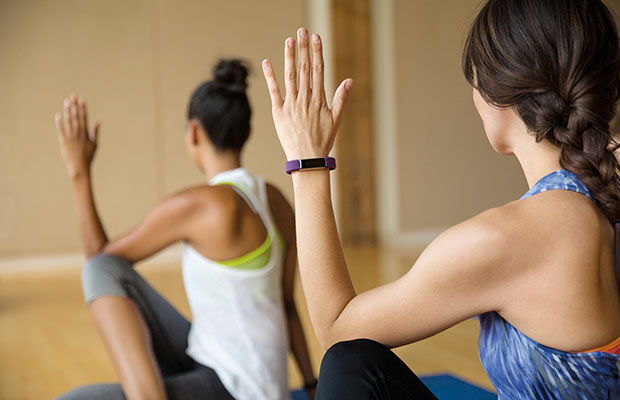
When the scale gets stale, we’re always looking for fresh ways to track progress. And luckily, it’s never been easier to monitor your health and fitness. Virtually anyone with internet access and an extra few bucks can hop on the quantified self bandwagon.
For proof, look no further than the ubiquitous Fitbit, which in 2015 reported 9.5 million active users and 21 million Fitbits sold, each boasting a range of features, from a simple step counter to sophisticated sleep and heart rate monitors. Curious just how intense your HIIT workout was? Or need a daily reminder to kick your sedentary ways to the curb? This gadget has you covered, whether it’s creating new, healthy habits — or simply reinforcing them.
RELATED: 20 Meal Prep Pics from the Healthiest People on Instagram
That’s why we synced up with some of Fitbit’s most dedicated users (most of whom are Daily Burn 365 devotees, too!) to steal their best-kept tracking secrets. Once you get your hands on the device — or finally dust it off — success is yours for the taking.
7 Insider Tips to Level Up Your Fitbit
1. Find your angle.
Trackers can do a whole lot of things — but there’s no need to commit to the whole kitchen sink. “Experiment [to] see what aspect of your Fitbit…works for your health and wellness routine,” says host and university professor Hilary Russo. For Russo, a participant in Daily Burn’s live, daily workout show, it’s all about the food diary.
Your function of choice might change over time, as well. For example, says primary school teacher Sarah Adam, “Even though I am no longer trying to lose weight, I love seeing my resting heart rate get lower and knowing that I am getting fitter.” Keep your focus on whichever aspects of the gadget suit your needs and goals at any given time. And don’t feel pressured to use tools that don’t appeal to you — that’s a surefire way to lose motivation.
RELATED: Daily Burn 365: New Workouts, 7 Days a Week
2. Make every step count.
“On a good day, I try to get to at least 10,000 steps,” says university administrator Deirdre Folkers. “Sometimes my work keeps me at my desk for nine or more hours, so this can be a challenge.”
“It’s not a competition… We are all striving for our personal bests.”
Because of her demanding work schedule, Folkers has learned to get creative when it comes to meeting her goal. “I now visit the women’s room across the building from my office in order to force me to walk further,” she says. “I also will take a quick walk around the building as a fast break. At home, I may take a swing around the block if I notice that I’m close to my 10,000 steps. And I no longer feel bad when a trip to the grocery store is carried out inefficiently — I just count those extra steps that it takes to backtrack for half and half as extra steps towards my daily goal!”
RELATED: 3 Walking Treadmill Workouts Just for You
3. Pay as much attention to your body as you do to your device.
“Since using my Fitbit, I have had a goal of 10,000 steps a day,” says full-time mom Sarah Fontenot, who’s proudly able to reach her target most days. Perhaps even more valuable. though? Using the device daily has made Fontenot more aware of her body’s signals, particularly on days when she’s not able to hit her steps goal.
She’ll ask herself: “Am I being more sedentary today? Am I feeling sick? Am I just in need of a rest day after doing a lot of workouts recently?” The answers to these questions prove valuable in several ways, says Fontenot. “Knowing the reason for why I may be behind helps to shed any feelings of guilt when I may have just been in need of a rest day. It’s also a reminder to get up and move if I’m having a less active day.”

4. Be brutally honest.
“The food diary is a really honest way to keep it real,” says Russo. “Knowing what you’re [consuming] and what portion equates to what amount really… opens your eyes. It’s what helped me on my weight loss journey.”
Russo isn’t alone in this regard. Research consistently finds that keeping portion sizes in check is an effective strategy for anyone pursuing weight loss. And that doesn’t have to mean restrictive. Learning to identify healthy portion sizes can help ensure you’re able to continue eating the foods you love. (Yes, even high-fat foods such as cheese and fatty meats.) But in order to learn what constitutes a healthy portion size for you — and to determine whether you’re consistently eating the right portions — you have to commit to recording the whole truth (and nothing but the truth).
RELATED: 5 Super-Smart Ways to Avoid Portion Distortion
5. Get nerdy with it.
Progress graphs, FTW. Regardless of which aspects of the tracker you choose to use, log into the online app component and see your progress laid out in visual form. Not only can all those graphs and pie charts be a great way to boost both accountability, they can help keep you stay motivated, too. “I try as much as I can to enter all of the calories I am consuming in a day,” says Fontenot, who appreciates the app’s food log. “When I can visualize how many calories I have consumed…it really helps me to make smarter choices throughout the day.”
RELATED: 6 Printable Meal Planning Templates
6. Make it social (but don’t compare yourself to others).
“The Fitbit user forums are great… for questions, hints, tips and tricks,” says Adam. And there’s value in completing challenges, Fontenot adds. “I love the ability to chat with other participants doing the challenges with me. It’s so motivating to me,” she says.
If you do opt in to the gadget’s social features, just be wary of comparing yourself to other users. “I find that it is not wise at all to compare notes with other people, as there are so many variables at play,” she says. “It’s not a competition… We are all striving for our personal bests.”
7. Use it.
Everyone interviewed stressed one tip above all others: If you want your Fitbit to assist your health and wellness goals, then you actually have to use it. “Put it on when you get dressed, and keep it on throughout the day,” says Folkers. And remember to look at it periodically so that you can course-correct throughout the day (instead of realizing at bedtime that you only walked 500 steps).
Using the device on a daily basis will also help keep you accountable. “I believe that consistently wearing the Fitbit will give the best overall picture of how I am doing with my activity level,” says Fontenot. Similarly, “Using the food tracking and water tracking consistently helps me stay accountable, and I believe that accountability is essential to achieving my health and fitness goals.”
